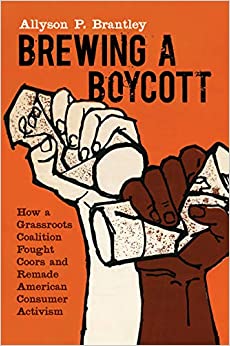The Book
Brewing a Boycott: How a Grassroots Coalition Fought Coors and Remade American Consumer Activism
The Author(s)
Allyson Brantley

Allyson Brantley’s excellent Brewing a Boycott recounts how different groups participated and engaged in boycotts of the Coors Brewing Company in the final decades of the twentieth century. Coors, she tells readers, was more than just a beer company, and the various consumer and employee-driven boycotts of its products were more than just targeted economic actions. The Coors company and, more specifically, the Coors family, was not only deeply hostile to organized labor, but also involved in a range of new right conservative causes. Consequently, what began as a boycott driven by the company’s discriminatory hiring practices eventually evolved into a more expansive set of issues, what “left-wing and student radicals called out the ‘fascist and racist politics promoted by the Coors family.’”[1] From an early point in the brewery’s history, Coors was determined to exercise an enormous amount of control over employees. Brantley points out that Coors even used lie detector tests when hiring new employees and when dealing with labor disputes. The first conflict that Brantley takes up was between the company and UBW Local 366 in 1957 – a contentious period in Coors’ history that set the tone for subsequent labor disputes with the company.
However, Brantley’s narrative begins in earnest during the following decade. By the late 1960s, the Chicano activist movement took up the fight against Coors, expanding the significance and scope of the boycott. As Brantley writes, “the Chicano boycott of Coors evolved from serving an instrumental purpose (with a clear end point in mind) to an expressive effort, in which the significance of one’s participation in the boycott overshadowed discrete bullet points on any list of demands.”[2] This phase of the boycott brought together workers protesting the company’s plainly racist and exclusionary hiring practices with others, including Chicano student activists at the University of Colorado, Boulder.
In the 1970s, Joseph Coors (the son of the brewery’s founder, Adolph Coors) supported and was involved in a number of conservative causes. Most substantially, it was Coors money that established the Heritage Foundation. In some ways, because the family was so involved in conservative politics during the 1970s and 1980s, boycotting the brewery was a proxy fight for larger political struggles. As she writes, eventually “gay men and lesbians, feminists, Chicanos, union members, and college students joined the struggle for human dignity.”[3]
The book’s geographic scope is often fascinating. While primarily centered in Golden, Colorado, where the company was headquartered, parts of the story recover the ways in which this boycott intersected with local politics in a number of places, such as San Francisco, California. As Brantley points out, “Multiracial coalitions thus crisscrossed the Bay Area by the early 1970s, paving the way for new intersectional politics.”[4] Indeed, the Coors boycott soon brought together a coalition of different groups that included the Teamsters Local 888 and a growing gay rights movement. As Brantley demonstrates, these sustained boycotts prevented Coors from distributing its beer to a number of bars and other establishments, having a clear impact on the brewery’s profits. In later chapters, the narrative returns to Colorado and a protracted dispute between the Brewery Workers Local 366 and Coors that erupted in the late 1970s. However, in 1978, the brewery was able to “break” the union. By the end of the year, Local 366 did not represent the union.
The rich history Brantley uncovers links several different historical moments in which different groups, sometimes working in direct coordination with another, boycotted the company for a variety of reasons. In order to tell this complex story, Brantley relies on an array of sources, including numerous archival collections. The breadth of this research allows the author to find connections among figures such as Cesar Chavez and Harvey Milk, as well as previously obscure activists.
Throughout, Brantley’s narrative calls attention to the strengths and weaknesses of such coalitions. Brantley does an impressive job of providing a fine-grained analysis of the internal dynamics of these different activist and labor groups. While alliances between labor unions and other groups resulted in some tangible successes, the boycott lost its power in the late 1980s through a negotiation between the company and the AFL-CIO, as well as a variety of targeted public relations efforts.
Brewing a Boycott makes more than one important scholarly contribution. In detailing Coors’ political activities, Brantley’s book adds to the growing literature on the conservative turn in American business, particularly in the 1970s. Historians will find much in this book that maps onto other studies of this conservative mobilization. Indeed, the book adds considerable depth and detail to the role that businesses played in the broader rightward trend during these decades. Perhaps more significantly, though, Brantley’s examination of the boycotts themselves reveals a great deal about the complexities involved when different groups work together towards common goals. Because the book’s scope is ultimately wider than a labor or consumer history, Brewing a Boycott will be of interest to historians focusing on different facets of capitalism in the twentieth century. Those interested in U.S. political history during the final decades of the twentieth century will also find much in Brantley’s work.
[1] Brantley, 74.
[2] Allyson Brantley, Brewing a Boycott: How a Grassroots Coalition Fought Coors and Remade American Consumer Activism
, (Chapel Hill: The University of North Carolina Press, 2021): 38.
Brantley, 123.
Brantley, 80.
About the Reviewer
Gavin Benke is a Senior Lecturer in the CAS Writing Program at Boston University and the author of Risk and Ruin: Enron and the Culture of American Capitalism.

0